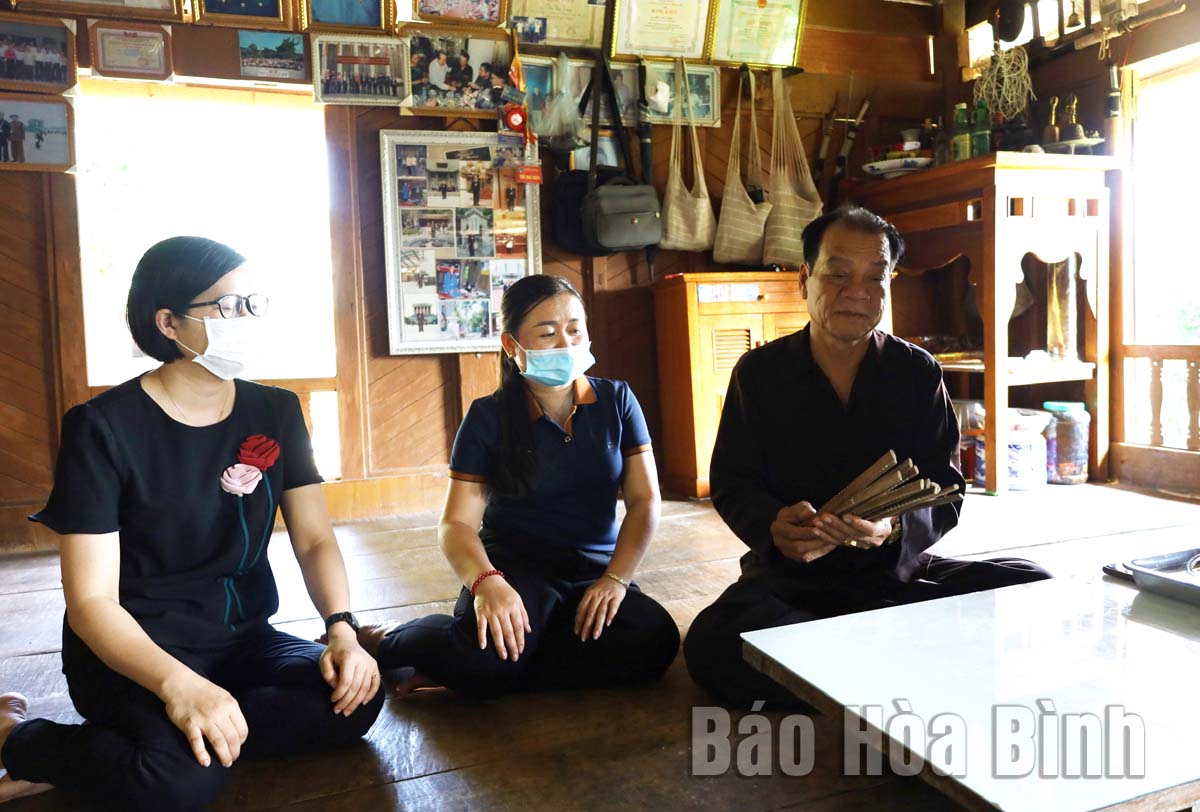
(HBO) – Coming into being very early in the history of the Muong ethnic group and containing unique values, the bamboo calendar, called Doi or Roi calendar, of Muong people in Hoa Binh province was recently honoured as part of the national intangible cultural heritage. Basing on the time division in a year and the movement of the moon and stars, local residents discovered and have applied the rule of the nature to their daily life.
Photo: Mo artisan Bui Van Lung in Phong Phu commune, Tan Lac district,
uses the bamboo calendar to forecast good days for local people’s affairs.
Bui Van Lung, a Mo Muong artisan in Muong Lam
hamlet of Phong Phu commune (Tan Lac district), said that the bamboo calendar
plays a special role in the life of the Muong community and also forms a
priceless treasure of folk knowledge. Aside from the popular Western calendar,
all production and daily activities, as well as customs, rituals, festivals and
important events of each person and family in the Muong community in Hoa Binh,
are based on the bamboo calendar.
The calendar comprises 12 carefully made bamboo
bars which are inscribed with notches, lines, and holes called symbols that
represent days, months, and natural phenomena in a month.
The bars are inscribed with 30 notches
representing 30 days in a lunar month.The days from the 1st to the 10th
are called "cay” days, the 11th to 20th "long” day, and the21st to 30th
"cuoi” days. Muong people often hold important events on the first days ("cay”
days) of a month.
At present, apart from being used in the community,
the bamboo calendar is also kept at the Muong Cultural Space Museum and the
private Museum of the Muong Culture in Hoa Binh city to preserve and introduce
it to local residents and visitors from far and wide.
Artisan Bui Thanh Binh, a researcher of the
Muong ethnic culture, said that the calendar is the quintessence built up over
many generations of Muong people and also a typical demonstration of the Muong
- Viet people’s consciousness of the world, obtained through their observation
of the movement of the moon and the Doi (Roi) constellation.
Until the late 20th century, the bamboo calendar
was still used across the areas of Muong people. Nowadays, there remain five
ancient sets of the bamboo calendar dating back hundreds of years and more than
100 new ones being used in the community in Hoa Binh province.
Together with the Khai Ha Festival, the bamboo
calendar of Muong people in Hoa Binh was recognised as part of the national
intangible cultural heritage in 2022.
Luu Huy Linh, Deputy Director of the provincial
Department of Culture, Sports and Tourism, held that it is necessary to enhance
the bamboo calendar preservation, step up communications and research to teach
locals in how to apply it to their daily life, and make use of the calendar and
other special cultural heritage pieces to develop tourism./.
Phong Phu commune, Tan Lac district of Hoa Binh province, is widely regarded as the cultural heartland of the Muong ethnic group. Among its many traditional communities, Luy Ai hamlet (formerly Ai hamlet) stands out as a rare location where the customs and way of life of the Muong Bi people remain largely intact.
The Truong Kha temple festival, a distinctive cultural event held every three years in Vu Ban township, Lac Son district, returned recently with vibrant rituals and folk traditions of the Muong people. Located next to the Buoi River in the Muong Trao fields, the Truong Kha Temple is dedicated to the three Kun Dol deities, revered for teaching farming techniques, irrigation, weaving, and protecting the harvest.
The demand for spaces serving community activities of residents in various areas across Hoa Binh city has been satisfied as local cultural houses now feature modern, spacious facilities thanks to the effective implementation of Resolution No. 49/NQ-HDND issued on December 28, 2021 by the city People's Council, which approved the plan for reorganising, converting, and allocating land for the construction, repair, and expansion of cultural houses in Hoa Binh’s villages and residential areas until 2025.
At the end of May, the Hoa Binh Provincial Ethnic Arts Troupe organized a series of performances for residents in Region 2 and Region 3 communes across the province. Bringing art to ethnic communities in remote, isolated, and especially disadvantaged areas has become a meaningful activity. These are not merely artistic performances but also journeys to disseminate cultural values, enrich spiritual life, and contribute to preserving the cultural identity of ethnic minorities.



